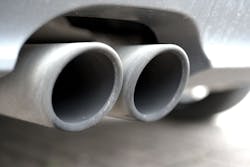In workplaces such as garages, bus depots, and warehouses there is a lot of pollution caused by diesel engines. The engines produce toxic gases and particulates that can cause serious health risks and legal liability. Although it is well known that fumes are toxic and protective measures should be taken, that isn’t always done.
A recent publication in the English newspaper The Guardian underlines that boldly, heading “UK legal claims grow over exposure at work to toxic diesel fumes.”
“Same as asbestos in the 1930s”
The article appeared in response to an accusation of an employee of the Royal Mail. The employee who worked at a major depot where he says he was exposed daily to diesel exhaust pollution for eight hours per shift. He says the exposure led him to develop asthma, and he provides medical evidence to support his claim.
The legal claim is no incident, according to Dan Shears, health and safety director for the GMB union. He says, “We strongly believe it is a major problem. There are potentially lots of people who have unnecessarily suffered premature death, who may have been affected by industrial exposure. We are now with diesel in the same place we were with asbestos in the 1930s.” Also Unite, Britain’s largest trade union, stated that exposure to diesel fumes is a ticking time bomb.
What are diesel fumes?
Diesel engine exhaust emissions (commonly known as ‘diesel fumes’) are a mixture of gases, vapours, liquid aerosols, and substances made up of particles. They contain the products of combustion including:
- carbon (soot)
- nitrogen
- water
- carbon monoxide
- aldehydes
- oxides of nitrogen
- oxides of Sulphur
- polycyclic aromatic hydrocarbons
The carbon particle or soot content varies from 60 percent to 80 percent depending on the fuel used and the type of engine. Most of the contaminants are adsorbed onto the soot. Petrol engines produce more carbon monoxide but much less soot than diesel engines.
Quantity and composition
The quantity and composition of diesel fumes in your workplace may vary depending on:
- the quality of diesel fuel used
- the type of engine, e.g. standard, turbo, or injector
- the state of engine tuning
- the fuel pump setting
- the workload demand on the engine
- the engine temperature
- whether the engine has been regularly maintained
Health risks
Breathing in diesel fumes can affect your health and exposure to the fumes can cause irritation of your eyes or respiratory tract. These effects are generally short term and should disappear when you are away from the source of exposure. However, prolonged exposure to diesel fumes, in particular to any blue or black smoke, could lead to coughing, chestiness, and breathlessness. There is some evidence that repeated exposure to diesel fumes over a period of about 20 years may increase the risk of lung cancer. Exposure to petrol engine exhaust emissions does not have the same risk.
Measures to be taken
To prevent hazards, an employer should take measures. Health and safety authorities all over the world set up guidelines about how to protect people, working in areas full of diesel fumes. For instance, the British HSE (Health and Safety Executive) strongly advises a combination of specific control measures, such as:
- workplace air extraction fans
- tailpipe exhaust extraction systems
- the use of filters attached to tailpipes
- catalytic converters
In addition to the control measures described, an employer should also ensure that:
- any engineering controls used are properly maintained and checked regularly
- where necessary, the exposure to diesel fumes is monitored
- employees are provided with the necessary information on the risks of exposure of diesel fumes
- employees are provided with instruction and training on the safe use of the control measures and any personal protective equipment that they are using
Information provided by Plymovent


